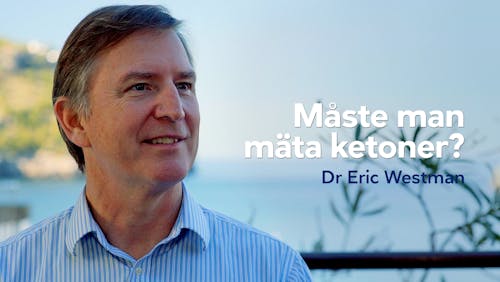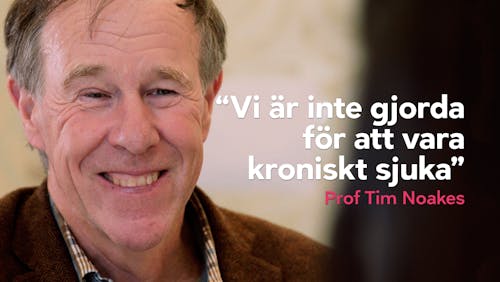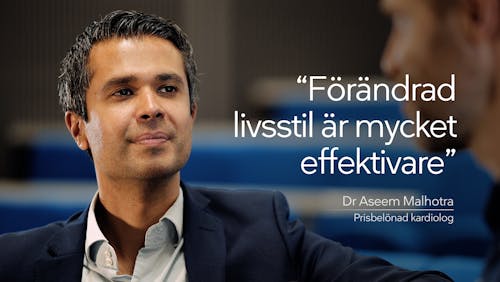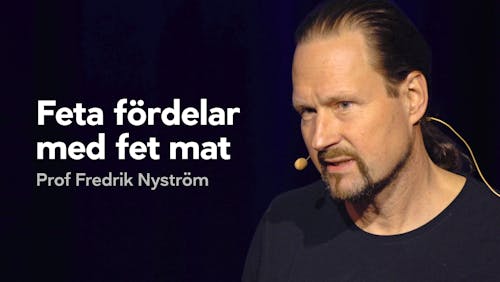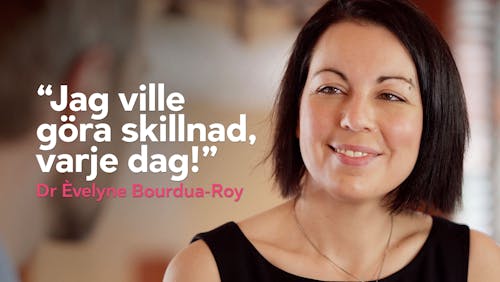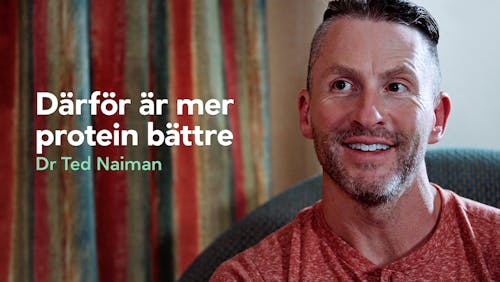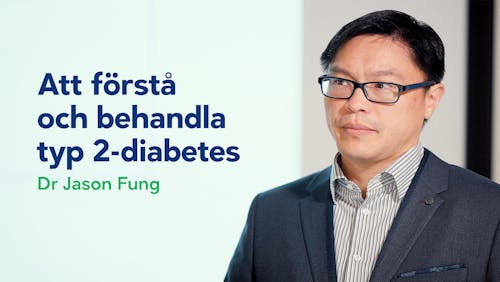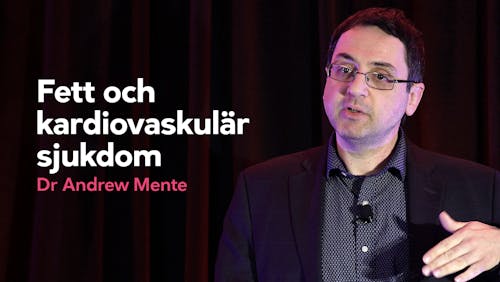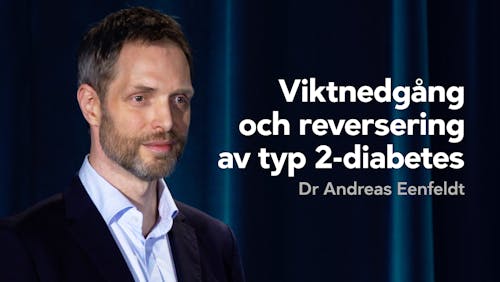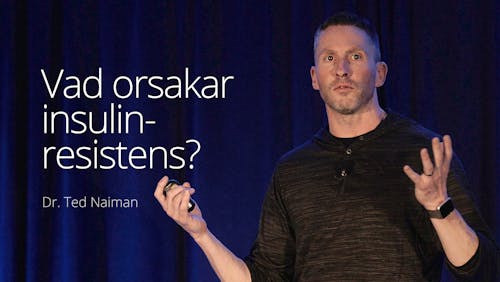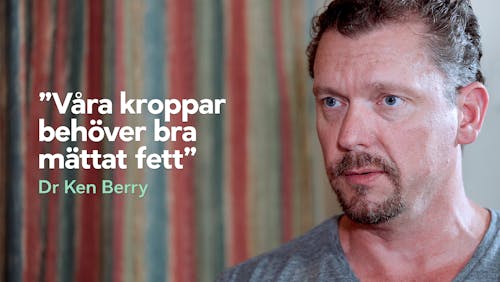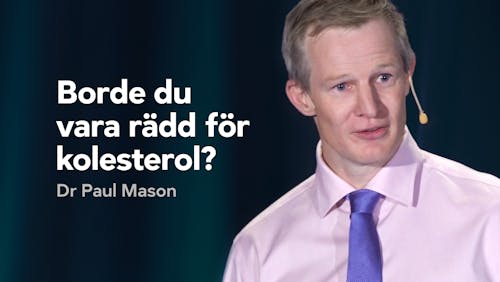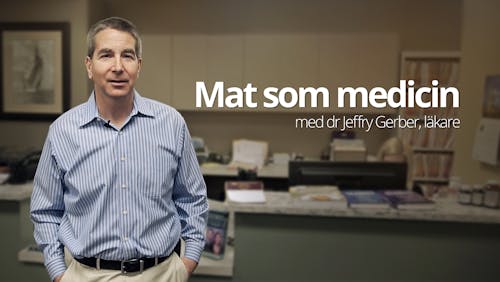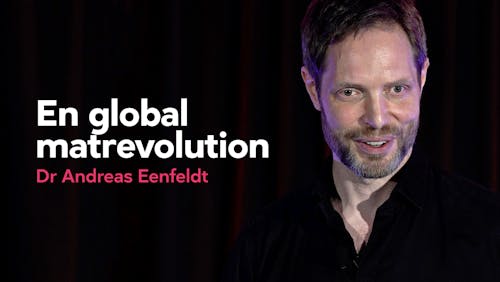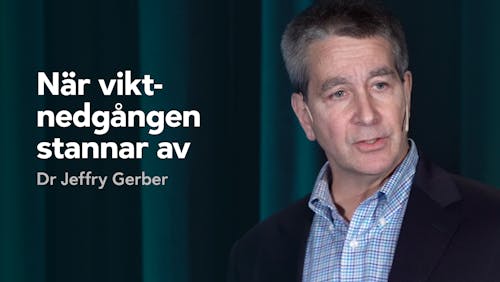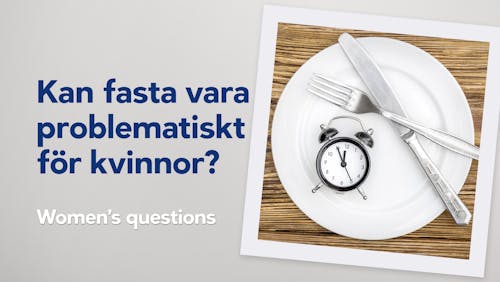Diet Doctor Podcast #5 – Dr Michael Arata & Stephanie Kennedy
Som tur är insåg han att han potentiellt kunde rädda fler genom att ha ett funktionsmedicinskt perspektiv på prevention, snarare än med ingripanden i sista minuten. Han började samarabeta med hälsocoachen Stephanie Kennedy för att lära ut växtbaserad ketogen kost och ett holistiskt förhållningssätt till hälsa för att förebygga de kroniska sjukdomar som plågar oss.
Den kommande boken, Keto with Plants, är en sammanfattning av deras erfarenheter och vilja att hjälpa tusentals patienter med sitt budskap. Jag älskar filosofin där man värnar om patienterna och det var snabbt tydligt att de är experter på att hjälpa sina klienter med praktiska livsstilsförändringar som fungerar på en gång och på sikt. Du kommer säkert att få en hel del värdefulla tips i den här intervjun!
Lyssna här
Du kan lyssna på avsnittet via PodBean (enbart ljud) eller på YouTube (ljud och video), båda länkarna finns ovan. Vår podcast är också tillgänglig via Apple Podcasts och andra podcasttjänster. Prenumerera gärna och lämna ett omdöme, det hjälper verkligen till att sprida budskapet och fler personer hittar till podcasten.
Och… om du är medlem (första månaden gratis) kan du ta del av kommande avsnitt här redan nu. (Med ditt svenska medlemskap kan du logga in även på vår engelska sida.)
Innehåll
2:15 Hur dr Michael Arata, som röntgenläkare, började dela ut råd om livsstil
5:20 Så förändrades Michaels liv när han besökte en konferens för funktionsmedicin
8:20 Om Michaels egen kliniska erfarenhet, där han behandlar sina patienter holistiskt
10:28 Olika typer av ketogen kost
12:56 Att vara i ketos med tidsbegränsat ätande och längre fasteperioder
17:10 Hälsocoach Stephanie Kennedys bästa tips för växtbaserad ketogen kost
21:00 Cykla intag av kött
25:40 Om tillskott
32:47 Tankar om olika typer av olja
37:40 Kontroverser kring växter
39:05 Tankar om carnivore
41:45 Vilka hälsomarkörer behöver man följa för att veta om patienten är på rätt väg?
43:45 Berätta om den kommande boken — Keto with plants
45:34 Bortsett från nutrition och mat, vad gör oss friska?
49:25 Slutord
Transkription (på engelska)
Dr. Bret Scher: Welcome to the DietDoctor podcast, I’m your host Dr. Bret Scher. Today I’m joined by Dr. Michael Arata and Stephanie Kennedy. Dr. Mike has an amazing story as many physicians do who transition to being more of a lifestyle and nutrition based physician. He’s an intervention radiologist and specializes in limb salvage, which means he’s sort of the last resort before someone has an amputation to try and save somebody’s limb.
It’s very high-pressure intense work. But like a lot of physicians he realized he wasn’t really affecting the problem in a good enough way to prevent it and that’s when he transitioned. Plus with some of his own health challenges which we’ll talk about. And what they’ve developed is a functional medicine lifestyle practice and as part of that they focus on a low-carb ketogenic diet.
But they focus on it from a plant basis, so primarily a vegan ketogenic diet, but here’s the key – with cycling. And that’s something that’s going to keep coming up over and over again, because the more we learn about it the more we realize how important cycling is. And that means cycling with intermittent fasting and cycling with meat.
And we’re going to talk about that. We’re going to get into some of the controversies about plants versus carnivore diet versus a balance of all that, talk about their philosophy of how they approach their patients and some of the concerns with a vegan diet, what you need to be careful monitoring for, and of course talk about their book that’s coming out, Keto With Plants.
So I really enjoyed this interview, I like their perspective a lot and their approach to the patient and their sort of balanced way of approaching people to help them not only understand the science, but understand how to implement it and how to make the changes last. So I hope you enjoy this interview as much as I did.
If you want to learn more about us you can visit us at DietDoctor.com or you can visit me at lowcarbcardiologist.com. Thanks a lot and enjoy the interview with Dr. Michael Arata and Stephanie Kennedy. Dr. Michael Arata and Stephanie Kennedy, thank you so much for joining me on the DietDoctor podcast.
Stephanie Kennedy: Sure.
Dr. Michael Arata: Pleasure to be here.
Bret: It’s actually Dr. Mike, right?
Michael: Yes.
Bret: You’ve had quite an interesting journey so let’s start with you. It always fascinates me how people find their way in medicine to focusing more on lifestyle and treating the whole patient. And I remember when we met yesterday at lunch, we were talking about it and I said, ”You must have an internal medicine or family practice background to get to this point”, and you said, ”No, interventional radiology” and that is not what I expected.
So you’re an interventional radiologist, you spend like all day in a cath lab like suite sticking catheters and needles in people and draining things and opening arteries and yet you transitioned to wanting people to work on their lifestyle. So give us a little bit of background on how you got to that point.
Michael: I think as an interventional radiologist I was drawn to the technological aspects of the specialty, the innovative nature. I mean interventional radiologists have created all kinds of different treatments and taken different devices and modified them and, you know, it’s very much a gadget type of field.
Stephanie: He loves his gadgets.
Michael: I do, no question. So that’s what really drew me to it and then, as I got into my practice I really enjoyed some of the things you could do that were alternatives to big surgeries that could produce outcomes in patients that couldn’t even tolerate the surgeries. So they were too sick to have a surgery and you could step in and intervene and make a difference in someone that maybe had no options at all.
So that was very satisfying but as I got more into limb salvage most of the patients typically would be either diabetics or renal failure or both, and those patients you could get a good result in the short-term, but unfortunately most of those patients… it’s not a long-term solution. You could spend three, four hours on a case basically vascularizing someone from their abdominal area all the way down to their toes and actually get blood flow back to their feet, that could heal their ulcer, but three months later they’re back.
And, you know, when you are doing one of these cases wearing 30 to 40 pounds of led and you know it gets really hot in it and really it’s actually quite fatiguing in those long cases, so at the end of it you’re gratified by the fact you’ve helped the person, but then you’re really disappointed when they come back.
And it just got me thinking, ”There’s got to be something better. How can we allow this to happen?” is really what I would start to question. And I didn’t have the knowledge base, the experience, the exposure to understand what got people to that point to the degree I needed. Fortunately I started working with other patients who had naturopaths as part of their care team.
And my interactions with them really started to basically plant the seed that there is something different. And I think a key part of this for my story is I was a biochemistry major as an undergrad. So when I started discussing things with naturopaths, they often talked about the biochemical aspect of it. That really resonated with me.
And fortunately one of the naturopaths I worked with suggested I should go to a functional medicine conference. When I went, my life changed, it literally just flipped a switch. And I was just like, ”Oh my gosh, this is it.” And it really is a biochemical based aspect, you know, there’s a lot of different overlapping specialties, integrative medicine, functional medicine, and these things are not that different, I mean there’s a lot of overlap, but one of the key things about functional medicine is it’s more systems biology and biochemistry based.
So I think I needed that. I don’t think I would have made this transition without that science core to it. Well, with this knowledge I was learning I experimented on me. And being someone that was working 90 to 100 hours a week, I was a typical American. I had all the conditions that you see in middle-aged, now actually younger adults.
So I was not sleeping, I had sleep apnea, I weighed 230 pounds, I had gastroesophageal reflux, I had skin conditions, you know, eczema would flare up all the time.
Bret: Too busy taking care of everybody else to take care of yourself.
Michael: Yes, all of these things that just slowly drag you down and eventually lead to more serious conditions. Well, those things started clearing up, I started losing weight.
Bret: And what did you do? What was your intervention to–?
Michael: Well, the first thing was food and interesting enough, the first diet that I tried was a ketogenic diet.
Bret: That was the very first one. You got lucky.
Michael: And I felt great and the one thing I noticed was the energy level, the clarity of thought, I mean those were the things that really stood out to me, because I was so fatigued, I was just living on sugar and coffee. And I literally had one of those big 22 ounce cokes or whatever… I constantly had one of those in my hand all day. So I was basically, you know, mainlining caffeine and sugar to survive and function.
Bret: Which is not that unusual. I mean we react to it like it’s the worst thing in the world, but it’s actually not that unusual.
Michael: You look around and you see it everywhere. So that was the big switch and I started sleeping better. When I lost weight the sleep apnea went away on its own. I also had very bad hypertension. I first was diagnosed with high blood pressure in college in my 20s and I got to the point where I was on four medications and still had a pressure of 160/100, so I was really bad.
That started getting better and I actually was getting off medication. So it was an incredible experience just seeing what happened to myself when I did something that was not what I’ve been basically brought up in the system.
Bret: And that’s what’s so amazing that so many doctors have the transformation by having their own transformation and then they transform their practice, because we weren’t taught this. So we have to be able to go outside of what we were told as the way to do things.
So an incredible journey and then you opened up a practice where now you’re treating people holistically, you’re treating not just one problem in the IR suite, but trying to treat them in the whole person focusing on nutrition and ketosis as a cornerstone of that treatment.
Michael: Yeah, I think I obviously had to go through a lot of educational processes. Maybe I did too much but I just felt like I really needed to know this. And so it was an evolution and we’ve gotten to the point now where I do incorporate ketosis. I think it’s important to understand where I’m coming from, I’m not really someone that advocates or uses therapeutic ketosis. I mean I think it has its place but not with the patients that I’m seeing.
So we’re focusing on nutritional ketosis and while I did obviously jump right into the ketogenic diet for my first go-round, I also found that plants really make me feel well. And it was kind of a revelation for us both because we did it together. The first time we did wasn’t quite a vegetarian diet, but it was very plant heavy and we both felt tremendous. And Stephanie had been vegetarian before, so she had more experience with– I was a carnivore, I would go and have a big steak and just leave the plants.
Bret: So Stephanie, it was your influence then to get him to try the plants?
Stephanie: It was part of my training, it’s a functional medicine dietary new plan, so it’s really plant heavy and it’s dairy and grain free, so it wasn’t quite keto but it was just very plant and clean meats heavy. And even with a few clients it’s a challenging meal plan, because it’s a lot of more intricate recipes than I prefer to recommend because it does take a lot of work.
But the few clients I’ve gotten to do it, have said the same thing. Them and their husbands were like, ”Oh, my gosh, I feel so amazing!” And I felt like euphoric, just like this clean energy buzzing through. It was pretty amazing but yeah, it’s a lot of work.
Bret: That’s what’s so interesting about a ketogenic diet is there are so many different ways to do it. It sounds like it’s a one thing but it really isn’t. And some people are on one end of the spectrum and they’re carnivores. And some people are on the other end of the spectrum and they’re vegan keto. And they both can be in ketosis, they both can get benefits of ketosis and they both can feel great.
And one of the hard questions is, ”Is there one that’s better? Or if you’re feeling great it doesn’t matter?” I know you’ve had some experience with a little bit of all of this. So tell us about not just your own personal transition to a vegetarian based keto, but with your clients. Why you have felt that’s the better way to go?
Michael: I have to step back from trying to understand why we come to this conclusion, to get to a really core principle and that principle is that life is cycles. You can look at everything in life, you can look at night and day, you can look at the seasons, you know, your birth and your death. So the idea that we are static and we are going do the same thing over and over, it just isn’t compatible with every aspect of life, no matter where you look.
And so I think that is true with how we eat. And the other aspect of it is that when we look at how the body repairs itself and heals and grows, it’s response to a stimulus, so the stimulus is a change. So I think that’s an important element to eating. So I guess what I would say is there is no perfect diet.
Bret: Right.
Michael: What is perfect is to change, to have cycles. And if you look at the standard American more than just diet, let’s say a lifestyle, which we actually prefer over diet, the typical way that Americans live is static, constant stress, not moving, eating continuously throughout the day and generally high carbs, so there’s really not a change anywhere in there.
It’s a continuous exposure to something and our bodies are not meant for that, that’s not how we’re built. So I think that that’s where we came to the idea, let’s combine ketosis with plants and make it in a way that we actually incorporate cycling. And so I think in order to make that work and be practical, you have to fast. I don’t think you can do this without fasting.
Bret: So what length in fast do you think works best in certain situations?
Michael: We try to incorporate both, so we really like time restricted feeding, because I do think it’s important to eat breakfast. Again, that cycle, the circadian rhythm, key element in my opinion. So we like time restricted feeding at least a couple of days a week and then we also like to incorporate a more prolonged fast, typically five days. And one of the great products it’s out there that really facilitates this is the ProLon diet.
Stephanie: We love it.
Michael: It is fantastic. It makes fasting so easy to do. And let’s be realistic, if it’s not practical, people are not going to do it.
Bret: And that’s what’s interesting about the ketogenic diet is that I find people can fast much easier when they are already in ketosis. So you can say fasting five days is hard and for the average person it probably is. For the average person in ketosis I’m not sure how hard it is.
Michael: It’s not. At least from my experience. So with this in mind, we started to see how can we help patients and I started working with my own patients and my patient population is largely cognitive patients, so typically elderly patients. Again it has to be simple, it has to be practical. If you’re dealing with elderly people in general or more importantly cognitively impaired patients, if it’s not simple, it’s not going to work.
Bret: So fasting in elderly people can get a little tricky.
Michael: Well, the easy part for the fasting element with elderly patients is intermittent fasting. A lot of them do it on their own and they don’t even realize it. It’s only a 12 hour maybe, but they are actually doing it regularly. So getting them to extend it to 15 and 16 hours is not that big a stretch. It can get a little bit trickier when you start doing a more extended fast, but that’s why I think ProLon is fantastic.
And I’m regularly having patients well into their 70s using ProLon and finding it quite doable. And that again kind of fits in because it’s plant-based, so it’s just a nice fit for what we’re trying to do with the patients. And then the population that’s on the other end of the spectrum is I see young patients with dysautonomia and POTS.
Bret: Postural Orthostatic Tachycardia Syndrome.
Michael: Thank you.
Bret: Where you stand up and your heart rate shoots through the roof and you feel lightheaded and awful.
Michael: Exactly, so for that group the proportion that are related to autoimmunity it’s estimated to be a 50%, I think it’s actually higher. I think that we’re not identifying antibodies that could be 80% of that population. So I think it’s a strongly autoimmune driven condition and obviously the mitochondria are very much involved in it. And then of course the gut with the microbiome.
So for that population this approach, this lifestyle actually helps them too, which is really fascinating, it has actually surprised me. Because you have patients that wouldn’t think that fasting would help and it really does.
Bret: In the cardiology world people with POTS it’s frustrating, because there’s not a whole lot we have to offer them. You increase your hydration, you increase your salt, you can try and wear compression stockings but it’s fairly un-rewarding, because the they tend to not get better very quickly, but if a nutritional intervention like this can help them, I’ve got to start trying that with them, I haven’t thought of that before.
Michael: The first positive response I got that really blew my mind is a 22-year-old young lady and very debilitated, just basically could not function and within two days of fasting she started to tell me, ”I’m feeling better”. And she continued it and she’s feeling great. So it was really kind of, ”This is incredible!” and so I started using it more. And so again it’s kind of two ends of the spectrum. I personally wouldn’t feel comfortable with a child taking this approach and fasting, but I think a young adult absolutely, it’s very well-tolerated.
Bret: So, Stephanie, you are the day-to-day coach with a lot of the clients you see and the knock against a vegan keto diet is that it’s hard and you have to really prepare and spend a lot of time thinking about it to make sure you’re getting adequate levels of fat and protein and preparing all your food. So what are some of the tricks or the tips that you think are the top ones to help people who want to follow a more plant-based ketogenic diet?
Stephanie: Well, yeah colors, I would say I do eat the rainbow as I say, not Skittles.
Michael: Well, our system.
Stephanie: Yeah, we have a system where we’re organizing our foods into like I had Siebel at one point and I saw this list, it was like red, green, you know, you like the stoplights of foods you couldn’t eat and it really helped me because I’d be like at a restaurant, would put down my list, it was like a 14 page list or whatever, it was really fun.
So we’re organizing our foods into columns like that, so you could just, ”I can eat all these foods in the green list, all these foods”, so that’s kind of easy, but then if you don’t cook or whatever it’s just a list of ingredients too, so I have written a lot of recipes and I hate cooking and I am busy and lazy. I hate to say lazy, but I am, I admit it.
So I’m trying to cook with that in mind because I hate doing it. So it has to be something that can be like prepared in 10 minutes, I don’t like all these gadgets in the strainer and then then you end up with a huge pile of dishes at the end of the night. So they are simple and they are really tasty. I would say the key is we treat our food as a vehicle, with olive oil and MCT oils. So just anything… I make really good dressings and sauces and spices to try to get that in there and then I like to start the day with a smoothie.
This would be the first thing I’d help people add actually, rather than say, ”Okay we got to cut this and cut that”. I say, ”Let’s add to what you’re already eating a green smoothie in the morning.” So a couple of strawberries, a bunch of spinach, some hemp and avocado and MCT of course, so it’s really fat full and veggie full. And it sort of feels a lot of voids…
You know, you could eat like a ton of pizza but you can’t sit down and eat like buckets full of kale salad, because all the nutrients that your body wants have been met and it’s like, ”Ah, I’m good”, and it shuts it off. But with pizza it’s still like, ”I still don’t have it, I still don’t have it.” So you could just gorge.
So starting your day off or a lunch whatever you prefer for the green smoothie sort of ripples out and it kind of naturally has them cut back on other things, so it’s just a nicer start to, ”We’ll meet and add something to your diet instead of take it out.” So I try to do little twists like that to make these changes a little easier and we try to incorporate it a little bit more slowly rather than…
He can just turn on a dime and transform everything, but most of us can’t do that. So I tried to be like, ”Let’s prioritize the changes, let’s do them slowly and incorporate them and once it’s like working in your life then we’ll look and add the next one.” And so I kind of slow everybody down and keep it very realistic.
Bret: And that’s a great approach for people to hear because we talk about so much information and we give so many tips and people think they can just run out and do it right away. And yeah like you said, most people don’t work that way, it’s a process.
And so it’s great to have someone like you who can coach people along and really help them prioritize the process to understand what needs to change first and then what can follow after that. So people need to keep that in mind when they’re trying to make lifestyle changes, because if you try and do too much at once you can end up frustrated that it’s not all working.
Stephanie: You could maybe inoculate it for a short time and then be like, ”Oh, it didn’t work!” Then you’re like, ”Oh, another one that failed that was just too much.”
Bret: Now, when you were talking about cycling, and we talked about this a little bit at lunch the other day, you also mentioned about cycling with meat. So it’s not that you’re 100% all plants, no meat, but it seemed like you felt, if I can put words in your mouth, that cycling with meat was also important, so talk to me a little bit about that.
Michael: Sure, I think if you separate out vegans, because there’s a lot of people that choose a vegan lifestyle, it’s more than the food. There are other issues that led them to that way of living. And I think that for our style it’s possible to maintain a vegan ketogenic style of eating, but it’s difficult.
We will be the first to tell you, it’s difficult. If you’re more of a vegetarian plant-based it’s certainly much easier to do, but the way we eat is actually to have some meat. And the way we do that is we try to eat meat in a 24-hour period roughly once a week. Now we don’t always stick to that.
Certainly things like conferences and traveling, it gets a little bit more challenging and so we’re flexible and pragmatic about it, but ideally we would say, ”Go through your weekly cycle”, which we do a five-day plan and we try to encourage people to do three days of time restricted feeding in that five days and then have a meat up day. And for that day you have meat with each meal. Now it’s not necessarily gorging on huge steaks.
We’re talking small serving sizes, but you’re having animal protein with each meal. And the way I like to think about that and the way I explain it to patients is that we are omnivores and to think there were omnivores that had access to animal meat every day is not realistic. You can just look around the environment and what would happen is you would have a kill. You would capture some sort of animal, whether it’s a fish or bird, a rabbit or whatever it is and you would eat a lot of it.
You would eat it for, you know a day or two, while it’s still fresh. And I think that’s how our bodies are designed and so that’s how we style the plan is to do that. And what it’s doing is providing nutrients that you don’t necessarily get from plants. I don’t think that necessarily animal products are bad in that sense that some people do think they are as far as health goes, but I think the problem is that the meat that we have readily available is bad.
And my approach is kind of beyond macronutrients so we can talk about sugars and fats and things like that and that’s important but I think even more important are the fatty acids that are present in the fats. And if you look at the meat supply in this country, not only is the Omega 6 – 3 ratio really poor but you have really elevated levels of palmitic acid.
Palmitic acid is very inflammatory, it activates TH1 and TH17, so you not only have inflammation but you have revved up immune system and that’s what causes atherosclerotic plaques. So I think that if you have really good quality wild game it’s completely different than the hot dog that you get in your grocery store.
Bret: Absolutely.
Michael: So I think that’s important. And if you look at some of the things that become deficient in vegans in particular, there are things that actually meats are very rich in. So for example B12, carnitine, those are very key elements.
And in fact if you look at people who are ill, who are going to try to incorporate ketosis, they are going to struggle if they have mitochondrial dysfunction. So if you’re going to do a more plant-based ketogenic style diet on someone with mitochondrial dysfunction, they are going to struggle without carnitine. It’s essential. So meat is a great source of carnitine.
Bret: So is once a week enough to supply those people with the carnitine they need, or will you still supplement? And the same question for B12 as well.
Michael: Great question, so for the healthy individual I think you probably would do fine, which is once a week meat, but not sick patients. And so we would regularly recommend relatively high doses of carnitine supplementation. The B12, my preference is actually to test for it. I think the routine testing of key nutrients like vitamin D and B12, they are so easy to do and you can actually measure this and treat it as a titrated treatment rather than just take this pill.
Bret: So let’s talk about that for a second, because zero is a normal range in the lab and that is derived from thousands of patients who they thought were healthy and they checked their levels and defined the normal range. Does that apply… do you think that’s a true normal range? And where do you shoot for the levels in that range?
Michael: You can see she’s giggling so… No, I don’t. So I like to use the term ”reference range” and the reference range includes a lot of unhealthy malnourished people. So certainly with vitamin D levels I really would encourage people to do much higher than what’s considered normal.
Bret: So like 40 to 60?
Michael: That will be a bare minimum. I am usually shooting for 80 to 120.
Bret: Now isn’t there a risk of vitamin D toxicity at a too high-level?
Michael: It is actually quite rare and if you’re going to get in trouble with vitamin D, usually we’re talking about 30,000 units a day before you really see a problem. For someone who’s got kidney stone issues might be little difference with renal failure, but the average person can absorb 10 to 20,000 units a day without difficulty and not run in trouble.
And with B12 I actually prefer methylmalonic acid. I think the B12 levels get falsely elevated with dysbiosis, which is an abnormal mix of bacteria in the gut which actually produce B12 levels artificially. So I don’t necessarily find that a B12 level itself is very helpful. Methylmalonic acid I think is more telling.
Bret: Now that’s going to be a tough test walking into a doctor’s office and asking for it. That’s not going to happen.
Michael: No, it’s true. But fortunately now there’s direct labs for patients. So we obviously encourage people to work with their doctors, but if there’s a test that you’re interested in you can get them on your own, without your doctor’s order.
Bret: Yeah, so I think the good take-home there is if you walk in your doctor’s office and they say, ”Oh, your levels are fine, don’t worry about it”, don’t stop there, dig a little deeper because what applies to you is not necessarily what the normal reference range is. So rather than just supplementing, you test with the B12, but you would supplement with the carnitine in someone who does have some mitochondrial dysfunction, but someone who is healthy, eating meat once a week and you’re fine with not supplementing, just to summarize that.
Michael: Yeah, we haven’t seen that be an issue and obviously there are going to be circumstances that may arise where could be a problem. But in general I think a healthy individual with no indication of mitochondrial dysfunction is probably going to do fine if they’re getting enough meat one day a week.
Bret: And what about Omega 3s and iron and calcium, any concern with those?
Michael: So certainly the mineral component is a problem with ketosis becoming deficient in those minerals. We’re not really deeply in ketosis. So I don’t think it’s quite the issue that you had for example with the therapeutic ketosis.
Bret: And when you say therapeutic ketosis, are you talking about certain levels like above three for beta hydroxybutyrate, or you’re talking about using exogenous ketones? What do you mean when you talk about therapeutic ketosis?
Michael: Great question, so our goal is basically to get to 0.8, to 1.5. That’s kind of our level of ketosis that we’re shooting for. In that circumstance I don’t think we’re seeing a level of fatty acid oxidation that we’re going to deplete the minerals to the levels you would with someone to 3, 5 etc. With iron I think that with a menstruating female it makes sense to supplement iron, but I think most men it’s not a big issue.
And certainly if you have meat once a week I think you’re going to be okay, assuming there are no chronic illness. The things that I think that can be helpful in terms of supplementation on the mineral side, I think applies to most people is magnesium. I think most of us walk around magnesium deficient, so that’s one that I give basically to everyone.
And the other thing with that is there’s not a good test for it. So I don’t have a way to titrate it, so I just kind of give it to everybody. And generally it makes people sleep better and when people sleep better, they feel better. So that’s kind of just an automatic one for me.
And then if you look at the other aspects of the minerals, I think the food tastes better when you season it and so certainly just having them add salt to the meals, which most people are okay with and tolerate. I don’t think you need to get to the point where you’re using supplements. We just haven’t seen that to be a need.
Bret: Let me interrupt you for a second, so, Stephanie is that something that you try to incorporate in a lot of the recipes, different seasonings to help with the micronutrients? And what are some of your favorite ones for that?
Stephanie: Oh, gosh. I’m just thinking about my super lazy salad dressing would be like olive oil, lemon, Dijon and then I like to put Rosemary, or I mean thyme, thyme is my favorite, and then I always use Hymalaian pink salt.
I think all of the herbs a really good but one of my favorite mixes, I like to get mixes too, because I like to be quick, I’m trying not to use the word lazy, but Trader Joe’s, they have an organic herb salad mix, so you get kind of random bits of herbs in each of them, just kind of different, like dill, all kinds of stuff in them, so we try to use fresh herbs as much as we can in things that are so high on antioxidants and flavor let’s face it.
And what else do I put in there? I guess I don’t really keep track of what I do in that.
Bret: Well, I think that’s a good starting point and tips to find sort of prepackaged… You said that Trader Joe have the prepackaged ones that you can use and… Because, let’s face it, we have to keep things easier if we’re going to be compliant with it and that’s probably a big part of what you do is to help people stay on course.
Stephanie: But I do say you should make your own dressings, because in dressings they use canola oil or soybean oil or whatever as a base. I mean I’ve got times myself when he’s like, ”I’ve got to go, will you make me a lunch?” and I get a little tiny Tupperware cup and just squeeze a half a lemon, a scoop of Dijon, the olive oil, shake it up, mix it with some herbs, I mean it’s so fast but it’s so important to make your own dressing.
So I definitely don’t cut corners on dressings. But Trader Joe’s does have a mixed salad, I think it’s called the Green Goddess, and that’s an olive oil based one. And I’ll fit it out with a little olive oil, but it’s a nice one to give you a quickie boost.
Michael: So I would like to touch on the Omega’s, if I could.
Bret: Oh, yeah, please.
Michael: I think one of important things to understand about Omega 3 it’s the ratios what’s really important. And when you’re not consuming a lot of the more basically… what’s the word I’m thinking of?
Bret: Like the pro-inflammatory Omega 6s?
Michael: Yeah, so the food supply that we have is very much tilted towards Omega 6 and in particular the meats. So if you’re eating a plant–
Bret: The grain fed meats.
Michael: Yes, thank you for clarifying that. So the more plant-based that you eat the less you’re going to expose yourself with the inflammatory Omega 6s, so your ratio is a little bit more healthy. But the other thing that’s really important and I haven’t seen this necessarily in human data but from animal studies, when animals are fed a high mono unsaturated fat diet their requirements of Omega 3s dramatically change.
And so our main fat in our lifestyle is actually monounsaturated. Lots of olive oil, tons of avocados, nuts. So I don’t think that our clients need a lot of Omega 3, because what Omega three they have, is more effective I think, based on the studies, and the fact that they don’t have a lot of inflammatory Omega 6 that they have to balance out. So in general we’re not using a lot of Omega 3 supplementation for that reason.
Bret: So talking about that balance, so when you’re not using butter and ghee and lard as cooking oils, a lot of people will go to the Omega 6 vegetable seed oils, that’s sort of like a standard go-to when you’re not cooking with butter. So how do you counsel your patients for cooking oils and how do you keep them away from those?
Michael: Well we definitely don’t want them to go to those oils.
Stephanie: No, we teach them that they’re evil.
Bret: And what are some of your favorite substitutes?
Stephanie: Avocado oil.
Michael: So we really like to cook with avocado oil. And then we just literally encourage people to drink olive oil. So if we say at the end of your salad take your bowl and just finish the rest of your oil. So olive oil is fantastic and we really encourage it. And then I think MCT oil is what allows us to have the level of plants and carbs that we do. In fact with our color system if you do eat one of the red plants, you have to have a tablespoon of MCT to go with each serving to neutralize the effect.
Bret: So what’s an example of a red plant, Like a ”stop, don’t eat” plant?
Stephanie: Yeah, like the stoplight.
Bret: Not the red color, but a ”stop, don’t eat this” example.
Michael: So for example we both enjoy the tropical fruits and so pineapple will be an example. So what we’ll do is we’ll actually drown that pineapple in coconut cream. That’s what we like to do, it’s like a Pina Colada. But you can get the same effect if you make a smoothie. Let’s say you put pineapple in it, put a tablespoon of MCT in it. What you want to do is, you know, you’ve got… the red plants are basically ones that have carbs greater than fats, so that is one criteria for the colors and the grams of carbs are greater than 15 for the reds.
So an MCT has basically 14 g of fat per tablespoon. So if you add that tablespoon of MCT with your red plant, you basically get towards neutral, close to neutral on the fat – carb ratio. Now we would limit that to one serving a day but it allows you to have that sweet that people tend to crave. So it’s a way to incorporate flexibility and really stick with the lifestyle. Those fats in general are not the same as the other fats, in particular MCT.
The MCT is absorbed directly across the endothelium. It does not go through lymphatic and drag all these inflammatory compounds like polysaccharide, which is the component of bacterial cell wall, which is extremely inflammatory. I personally think that’s why saturated fats are unhealthy more than anything else. Is that they’re dragging all these inflammatory products in the blood stream.
So MCT is a way to avoid that and increase the fat content in your diet. It also is more prone to generate ketones, so it’s going to facilitate that process. So we’re really big fans of both MCT oil and olive oil in particular. The other oils we’d really encourage you to completely avoid as much as you can. And as a practical product… I always mispronounce the name… Myiaka?
Stephanie: I was going to circle back to that. If you like butter, the vegan cultured butter meat… it’s made out of coconut oil, but it tastes like cultured salted delicious delightful butter, it’s so good.
Bret: You can cook with it, you can add it to your vegetables high smoke point.
Stephanie: Exactly, very, very tasty stuff. That woman is a genius.
Michael: And we’ve done blind taste test and you cannot tell the difference between butter and this.
Stephanie: No, you cannot… the texture and everything.
Bret: That statement makes me think of the old days… I can’t believe it’s not butter. I’m not taking about that. Let’s get into some controversies about plants. Let’s talk about Dr. Gundry and his plant paradox book and the anti-nutrients, the lectins, the problems that plants can potentially cause for some people. What’s your take on that?
Michael: I think first of all I really respect what he has done. I like people to think out of the box. but to my knowledge there is not a lot of science behind what he’s espousing.
My personal take on it is that individuals that are sick, that have a leaky gut, are more than likely to respond well to his way of eating, because those toxins are going to be much more toxic to a compromised individual, whereas a healthy individual with a very intact gut lining, with an immune system that’s well-functioning, they’re not going to have as bigger reaction to these things.
I mean, clearly they are toxins, nature is pretty fascinating and it’s designed these seeds very well and there’s a reason why these compounds are in them. Just like there’s compounds in other aspects of plants that are very nurturing to humans. So I think it’s something that is important to consider with individuals who are ill, I don’t think it’s as important for healthy people. So that’s kind of our take on it. Am I speaking for you?
Stephanie: Yes, frankly if we get rid of them, what else are we going to eat?
Bret: So the next step then is that some people do feel better when they get rid of plants and that’s where this whole carnivore movement is coming from.
And Sean Baker being the king of the carnivore movement, because of just what a powerful and strong and imposing figure he is with the amazing things he’s accomplishing but then even people like Georgia Ede who take a more maybe philosophical approach to it and she has seen all the benefits in herself by getting rid of plants and going perfectly carnivore. And what is your take on that when you see people feeling better and sort of thriving on a pure carnivore diet?
Michael: think it would go back to some things that are similar in the sense of the biochemistry behind meat, I would say, in the sense that mTOR is a fantastic thing to stimulate, but do you want to have it turned on all the time your entire life? I don’t think so. Elevated levels of insulin growth factor, I mean these are things that have positive effects.
But like everything, if we really look at life, it’s in spurts. And so I think that these types of styles of eating can make people feel well, but I don’t think they’re a good choice for the longevity of their life. And that’s the thing, is we don’t have a snapshot of 20, 30, 50 years of eating a carnivore diet. We have months, or maybe a year or two.
Bret: Oh, people could point to, I guess the Maasai and the Inuit that they were close to a carnivore diet, maybe not completely, but they were close. So there’s some evolutionary basis there.
Michael: Well, I’ve also read some things that the Inuit diet is not what we think it is. That maybe is questionable and I’m not going to say that that’s a wrong style of eating, because I don’t think there is an ideal way. I think that the way you eat is very individualized and I think that the health of the individual and perhaps more importantly the composition of the microbiome makes a huge difference.
And most people have unhealthy microbiomes. And so if you eat meat only that is much easier on the gut to digest and you’re to have less issues with doing that with an unhealthy microbiome than someone who jumps in and has 50 g of fiber a day at the gate. They’re going to struggle.
Bret: That’s a great point. So one approach would be then if you’re having trouble with plants then maybe need to fix your gut first and then you won’t have trouble with plants. And that’s part of the problem as providers and as physicians and coaches taking care of these people, what markers to be followed.
Because when we talk about longevity sure we could talk about mTOR, but it’s kind of hard to measure mTOR on a regular basis. We can talk about MP kinase and PAK but those are hard to measure, so we have to find our surrogate so we use CRP, we can use IGF-I, we can use blood sugar and insulin. But what you find as the best markers that you think we can follow to see if somebody’s on the right track?
Michael: Well, I think the ones you actually mentioned those are the ones that I would tend to follow. I think it also depends on what the goals of the individual are. So for someone with purely longevity or say cancer prevention approach, that’s very different than say a cognitive patient. And I think that for a cognitive patient we do need to have anabolic effects. In fact, I often tell my patients, I say, ”If you want to build brain you build muscle.”
I really think the brain is tied to the muscle. And so in that individual we have to have periods of stimulation of mTOR. I think it’s very important. That may be an elderly patient and you may say, well are you putting them at risk for shorter lifespan or are you putting them at risk for cancer. I don’t know for sure, I don’t think so when it’s pulsed, and I think that’s the key.
If you look at most hormones, most hormones are pulsed. So I think you’re okay to periodically stimulate these things. I would be very hesitant to have someone like that be on a carnivore diet. I just would. On the other hand if you’re in your 20s and you’re trying to build a beautiful body, I mean that’s what you’re going to do. Who knows if that’s a good choice long-term though?
Bret: Yeah, very good point down. And now one of your exciting projects is your book, so Keto With Plants. And now what inspired you to write the book?
Michael: Well, I think as we kind of were exploring for ourselves and for our practice how to blend ketosis with a plant-based diet, we really started looking for help. Who’s doing this? Where do we look to for guidance? There’s not many people. So with that sort of dearth of information we decided we’re going to do this, we’re going to try and do the research, we’re to try and put together the food plans and make it really practical so I think that’s really important.
If we’re going to do that for ourselves in our practice we should make it available for everybody. And I think over the last year or two we’ve started to see more people become interested in this and start to go in that direction so I think it is a new trend let’s say. But we feel that getting a book is a great vehicle for us to get this experience that we’ve had out to as many people as possible.
Bret: Now is it mostly a recipe book or is there going to be some of your coaching involved in there too to help people stick with the program?
Stephanie: It’s a mixture of a lot… there’s the science in the beginning that I’m trying to tone down so that us, laypeople can… well, not you two, but me and the listeners can understand and decode. So yeah, there’s the science behind it for those who’d like to know why they’re doing these things. Then there’s a little bit of coaching elements.
So it’s like okay, I know you’re tempted overall your lives, but let’s not do that and just lay other foundation to make sure… to give people permission to take time to take care of themselves… and it’s kind of a mixture of everything just to lay the foundations for a good start of a change that’s going to become lasting. That was important too to us is that this change would be lasting for people.
Bret: Let’s talk about that. We spend so much time talking about that the food, but there’s so much more than just nutrition and food that makes us healthy and helps our lives. So you mentioned some of them with gratitude journaling and giving yourself permission to take time. So tell us a little bit more about what you think are the important pillars for people to have in their lives that will help just make their nutrition that much better for their lives and make their lives that much better in general.
Michael: Connection.
Stephanie: Yeah, connection to each other and well to yourself. Our modern medicine has separated our mind from our body so much and treat them separately, but the mind drives so much of it. I found this myself when I was struggling to lose weight.
I was obeying all the rules and the scale was just sitting there and I know I shouldn’t like get on it all the time, because I don’t like it, but I went on a five day meditation retreat and lost weight on the retreat and he kept telling me, ”It’s stress, it’s stress”, and I’m like, ”You take your stress and you just shove it… somewhere. I’m tired of hearing about this stress nonsense.” And it turned out he was right… whatever.
Bret: It’s hard to admit that sometimes.
Stephanie: Yeah, sometimes, but no, stress messes so many things up. And I didn’t feel like I was a stressed-out person, but I guess I just was. You know, unhappy things frustrated me and annoyed me really easily. So with the mindfulness… that taught me that you can kind of let go of those recurring thoughts that drive the negativity. And you can let go of even weight I guess if you can’t let go of negativity.
And then as women I think we don’t give ourselves permission, because we’re like we need to do this for everybody else and give, give, give, but you can’t give from an empty vessel and you know that’s just really true. So you actually owe it to your family to take time to take care of yourself, so that there’s more of you to go around, so it’s really your duty to take care of yourself first. So I think shifting the thoughts on that and then also the restriction thing, I try to shift the paradigm, you know, the thinking on that, that you are giving yourself nutrients rather than restricting the pizza, just kind of shift the–
Michael: The focus.
Stephanie: …the focus of it.
Bret: Yeah, and the words you use and the way you talk about it can be so important in reframing someone’s opinion of it and can affect your success and their success.
Stephanie: Right, so try to also find the right motivation, not, ”I want to be sexy”, or ”My doctor said I’m going to die”. We tried to reframe to be more like empowering positive psychology type. Reframed like… we like to be immediately rewarded, so I like to focus on how you feel after you eat a day like this.
So I really try to connect the mind and the body so that you are aware of what you’re putting into your body, how it makes you feel and then that becoming a motivator rather than this long term goal like, ”I’m trying to avoid cancer”, or ”Avoid dementia”.
That’s not motivating day-to-day when you’re in the trenches. So we try to get immediate rewards in place and stuff like that. So it’s a lot to pack into one book, and then there are recipes yes, you’re right. So yeah, it’s coming together.
Bret: So now do you have any meat-based recipes in there? Because you believe in cycling and doing this on occasion. Did you mention that in your book?
Michael: We don’t actually. I think most people have that covered.
Bret: You mean there’s enough out there, that’s a good point, a very good point. What’s the timeframe? I am excited to see this book come out.
Michael: Well, we got a couple of weeks left before we have to get it done. So we’re shooting for 28.
Stephanie: Mm-hmm, of August.
Bret: Very good. This has been a wonderful interview. I’ve really enjoyed talking to you Dr. Mike and Stephanie, thank you so much for taking the time. Any last words you want to leave our listeners with and where can they go to learn more about you?
Michael: Well, first of all, we really appreciate the opportunity to be here, it’s been terrific. You can find us online at www.ketowithplants.com and so one thing we like to say is that all of this is something that we’re into… we’re in together and I think that working in a collaborative nature both as professionals and as members of society is the best way forward. And I think that’s what I’d like to leave you with.
Stephanie: He means we as in you and all of your listeners and not just us. All of us.
Bret: Thank you so much for joining us on the DietDoctor podcast.
Stephanie: Thank you.
Michael: Thank you.
Om videon
Inspelad i San Diego, USA, i augusti 2018, publicerad i oktober 2018.
Värd: Dr Bret Scher
Kamera: Isaac Perez
Ljud: Dr Bret Scher
Klippning: Simon Victor
Missa inte
- ENDAST MEDLEMMAR
![Måste man mäta ketoner?]()
- ENDAST MEDLEMMAR
!["Vi är inte gjorda för att vara kroniskt sjuka"]()
- ENDAST MEDLEMMAR
![Feta fördelar med fet mat]()
- ENDAST MEDLEMMAR
!["Jag ville göra skillnad, varje dag"]()
- ENDAST MEDLEMMAR
![Intervju med dr Ken Berry]()
- ENDAST MEDLEMMAR
![Hur är det med fibrer?]()
- ENDAST MEDLEMMAR
![Att praktisera och förespråka LCHF]()
- ENDAST MEDLEMMAR
!["Min värk har minskat, doktorn"]()
- ENDAST MEDLEMMAR
![Att förstå och behandla typ-2 diabetes]()
- ENDAST MEDLEMMAR
![Tim Noakes rättegång]()
- ENDAST MEDLEMMAR
![Fett och kardiovaskulär sjukdom]()
- ENDAST MEDLEMMAR
![Våra kroppar behöver bra mättat fett]()
- ENDAST MEDLEMMAR
![En global matrevolution]()
- ENDAST MEDLEMMAR
![Lindra kronisk smärta med LCHF]()
- ENDAST MEDLEMMAR
![Women's questions – kan fasta vara problematiskt för kvinnor?]()
